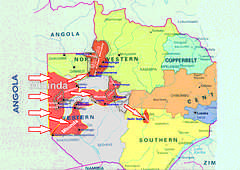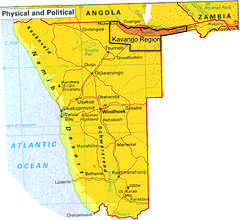Mbunda people
| Mbunda Mbúùnda | |
|---|---|
| Person | Kambunda |
| People | Vambunda |
| Language | Chimbúùnda |
| Country | Angola, DR Congo, Zambia, Namibia |
The Vambunda (singular Kambunda) (adjective and language Mbunda, Mbúùnda or Chimbúùnda) are a Bantu people who, during the Bantu migrations, came from the north, probably from somewhere near the present-day Sudan.

Their core is at present found in the Southeast of Angola from the Lunguevungu river in Moxico to the Cuando Cubango Province. In their migration they first settled in Kola in what is now the Democratic Republic of the Congo along the Kalanyi River, where they interacted with the Kingdom of Lunda and Kingdom of Luba,[1] in the 15th century under their ruler, King (Mwene) Nkuungu, with their capital at Namampongwe.[2] From there they settled for some time at the confluence of the Kwilu and Kasai rivers (now Democratic Republic of the Congo) in the 16th century, where they re-established their Kingdom.[3] A significant group of them still lives there, and The Mbunda language spoken by the Mbunda group that remained in the DR Congo, entirely separated from the rest of their people, is of course a special case. Due to passage of time and interaction with other languages, it has become quite different from the variants spoken in Angola, Zambia, and Namibia.
The Vambunda comprises a number of subgroups, each of which speaks its own dialect: Mbunda Mathzi (Katavola), Yauma,[4] Nkangala,[5] Mbalango, Sango, Shamuka (Chiyengele) and Ndundu, all of them alive in southeast Angola.[6]
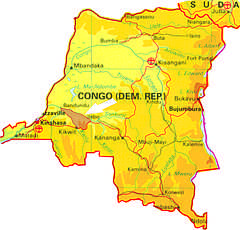
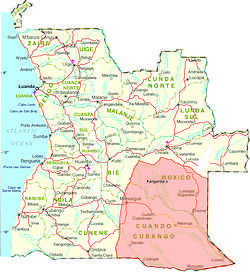
Origins and the legend of migration history
The Vambunda were among a group of Bantu people who left what is now Sudan during the Bantu migration in the early centuries to form one of the oldest and biggest ethnic grouping in Southern Africa and a Mbunda Kingdom in the 15th century [7]
The first Mbunda Monarch was King Mwene Nkuungu. Thereafter, the Mbunda shifted their base within the Kola area and settled in a place more favourable than their previous habitation, where they found Ruund (Luunda) people already settled. While there, Queen Vamwene Yamvu, the third Mbunda Monarch, married a Ruund (Luunda) hunter and relinguished her rulership to the husband[8][9] Her brother Prince Munamwene Nkonde was so incensed with her conduct that he led the majority of the disenchanted Mbunda populace away from the area and later settled near the confluence of the Kwilu and Kasai rivers.[10] Later, due to unfavourable weather conditions, the Mbunda in a two migration route moved south and south east into the now Angola in the 1600.
The Mbunda language spoken by the Mbunda group that remained in the DR Congo, entirely separated from the rest of their people, is of course a special case. Due to passage of time and interaction with other languages, it has become quite different from the variants spoken in Angola, Zambia, and Namibia.
In the southern route, to the south of the confluence of Kwilu and Kasai rivers, the fifth Mbunda Monarch, King Mwene Chinguli traveled all the way south to the now Cuando Cubango chasing the Bushmen and replacing them in the new found lands with the Mbunda descendants who were later known as the Chimbandi, the Ngonjelo, the Humbi, the Luimbi and the Nyemba.
In the second migration route and during the reign of Queen Vamwene Kaamba, the seventh Mbunda Monarch, the Mbunda explored and settled new lands to the east of the now Angola, where they discovered a great river, which they named Lindonga lya Mbayi, which literally means, "the great river of Mbayi", and abbreviated to Lyambayi, after one of the royal Princesses, Princess Vamunamwene Mbayi, one of the daughters of the sixth Mbunda Monarch, Queen Vamwene Mbaao, and who was a sister to Queen Vamwene Kaamba, drowned in this unnamed river's turbulent waters, in the process of crossing the river. Through the passage of time to this day, the Mbunda still call the Zambezi river “Lya Mbayi”. This was a very sandy area with small rivers which were all tributaries of the Zambezi River. Like the Zambezi these smaller rivers had very wide flood plains which were wonderful areas for grazing cattle. Even better the higher lands adjacent to the flood plains were ideal for planting their favorite crop, cassava. It was along these tributaries to the Zambezi that the first Mbunda decided to settle in a land subsequently named after them as Mbundaland, which is now part of Angola.[11]
The Mbunda set their first capital at Mithimoyi. However, the need for more settlement land was still vital to the quickly growing population. Queen Vamwene Kaamba sent some of the Mbunda to search for more settlement land to the south. The group settled at nearby river region called Luchathzi, who were later called after that river as Luchazi.
This expansion, which was later spearheaded by the 12th and 13th Mbunda monarchs, King Mwene Kathangila ka Mukenge and King Yambayamba Kapanda expeditions respectively, also gave way to dialects such: Katavola (Mbunda Mathzi), Yauma,[12] Nkangala,[13] Mbalango, Sango, Ciyengele ("Shamuka"), and Ndundu, all of which are close.[14] all of them alive in southeast Angola. Out of the two route migrations of the Mbunda from the confluence of Kwilu and Kasai rivers, southeast of the now Angola was inhabited by a thirteen Mbunda descendant ethnicity of the Mbunda Mathzi(Katavola], the Chimbandi, the Humbi, the Ngonjelo, the Luimbi, the Nyemba, the Luchazi, the Sango, the Mbalango, the Nkangala, the Yauma, the Ndundu and the Mashaka.
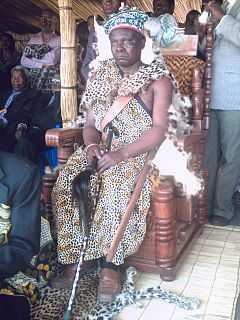
The Mbunda continued expanding southwards to a larger settlement, where the Mbunda Kingdom continued to flourish in what became known as Mbundaland from Lungwevungu river to Chibanda or southern border with Namibia, while Lumbala Nguimbo became their capital, where His Majesty King Mbandu III Mbandu Lifuti reigns today.
War with the Chokwe
Meanwhile, back in Mbundaland the Mbunda people were involved in a fiece battle with the Chokwe people. That came about after the death of the 19th Mbunda monarch King Mwene Katavola I Mwechela, who was believed to have been assassinated after an abolitionist cabal, clandestinely plotted against him due to his promulgating a royal decree which forbade intermarriages with other nationalities. His successor and 20th Mbunda monarch, King Mwene Katavola II Musangu, who was believed to be one of the plotters of his assassination contravened the royal decree of his predecessor by his passion for a Chokwe slave beauty named Nyakoma, who was owned by the Chokwe Chief called Mwa Mushilinjinji whom he allocated land to settle at the Luwe, a tributary of the Nengu river. The marriage proposal was turned down by Mushilinjinji[15] because it was a universal taboo for a royal personage like the king to marry a slave, no matter how attracted he was to her because the offspring of such a marriage could never qualify as royals. That resulted in his declaration of war against the Chokwe people and an attempt to chase them out of the Mbundaland. He was killed within a few days after the Mbunda-Chokwe battle, having been ambushed and killed by the Chokwe guards who then ran away, all the way back to their original homeland in the present-day Democratic Republic of the Congo. The war conclusively ended in favour of the Mbunda, with his predecessor and 21st Mbunda monarch, King Mwene Mbandu I Lyondthzi Kapova who waged a systematic war of vengeance against the Chokwe for his nephew's death.
It is as a result of those battles, that gave birth to the Mbunda and Chokwe cousinship, up to today, and extended to Zambia. However, the Chokwes who did not migrate to Mbundaland and remained in their country of origin, do not know about this cousinship that came about because of the King Katavola II Musangu war, because their forefathers did not witness that war. Some are only imitating the cousinship and applying it in a different way from the Chokwes and the Mbunda of Mbundaland. It is customary for most Africans to have cousinship relations after a war. It is a good custom because it heals the wounds of war and promote peace and friendship among the warring parties.[16]
War with the Luvale
King Mwene Mbandu I Lyondthzi Kapova also led the Mbunda in their armed confrontation with the Luvale who were anxious to break the military power and independence of the Mbunda state and wanted to capture slaves for sale. The two opposing military forces engaged each other in armed combat in the Lunjweva area where he shot and killed Masambo,[17] the leader of the invading Luvale forces. With the elimination of Masambo, the invaders were put to rout and forced to beat a hasty and disorderly retreat back to their homeland.[18]
Migration to Barotseland
At the end of the 18th century some of the Mbunda migrated to Barotseland, Mongu.[19] upon the migration of among others, the Ciyengele [20]
The Aluyi and their leader, the Litunga Mulambwa especially prized the Mbunda for their ability to fight. When the Luvale also known as Lovale invaded Barotseland from the north, the Mbunda countered the invasion and were victorious, ending the Lovale invasions.[21][22] King Mulambwa also cemented the bond of friendship between the Aluyi and the Mbunda[23] with a ten (10) point Mulambwa/Chiyengele Treaty[24] and ceremonially giving a sharp pointed pole called mulombwe to Mwene Chitengi Chiyengele and confirmed his stay in Barotseland as the Senior Chief of the Mbunda. This and other factors earned the Mbunda to be included on the Barotse National Council.[25][26]
Secondly, the Mbunda fought alongside Aluyi in the Aluyi/Makololo war in 1830, which ousted the Makololo occupation of Barotseland, leading to the establishment of the Mbunda Chieftainship at Lukwakwa under Senior Chief Mwene Sikufele now in Kabompo District, being a descendant of the Mbunda that supported Prince Mubukwanu of the Aluyi.[27] The Makololo from the south introduced the Sotho language spoken not only in Western Province today but also Botswana, Lesotho, South Africa and Caprivi Strip.[28][29]
The Mbunda also fought alongside the Aluyi against the Tonga in the 1880s, emerging victory as the Tonga had no defense against the Mbunda‘s skill with a bow and arrow, resulting in the Lozi/Mbunda and Tonga Cousinship. Later the Kaonde/Lozi war which Lozis won with the help of the Mbunda war machinery, resulting in the Mbunda Chieftainship of Chief Mwene Kasimba having firmly been established there at the confluence of the Lalafuta and Kyamenge in 1893, opposite Chief Mushima Njivumina of the Kaonde. In honoring the Mulambwa/Chiyengele Treaty, the Mbunda have remained the true allies of the Aluyi both in military and political matters.[30] The Mbunda lived peacefully, tendering their cattle and growing cassava, maize and rice, while many of the men left their homes to work in the South African mines. With Zambia independence from British rule that came in 1964, the practice was discouraged and the men were then recruited to work on the sugar plantations of Zambia.
Resistance to Portuguese occupation of Mbundaland
At the beginning of the 20th century due to their resistance to Portuguese colonial occupation, when the Portuguese colonialists abducted the twenty first (21st) Mbunda Monarch, King Mwene Mbandu I Lyondthzi Kapova, the Mbunda waged a fierce armed campaigns in defending their Mbundaland. Technology however, aided the Portuguese forces in gaining an upper hand in the war as they had a consistent supply of gunpowder for their guns. Without the knowledge to make gunpowder, the Mbunda eventually found their muzzle-loaders useless and increasingly relied on their bows and arrows as well as a few other traditional arms which were suited for close contact warfare. The Portuguese firepower took a heavy toll of the Mbunda, some of whom started to throw their muzzle-loaders in the rivers for lack of gunpowder. The Portuguese eventually dislodged the Mbunda Kingdom extending Angola territory over Mbundaland. This caused the second migration of the Mbunda to Barotseland.[31]
And later because of the impact of the Angolan War of Independence (1961–1974), the decolonization conflict in Angola (1974/75).[32] Independence came to Angola in November 1975 and with independence came Angolan Civil War (1975–2002). Again many of the Mbunda fled Angola to relocate in nearby western Zambia, this marked the third and fourth wave of Mbunda immigration to the now Western Province of Zambia. These refugees were related to the Mbunda who were already living around Kalabo, Senanga, Mongu, Kaoma, Lukulu and Kabompo in Zambia. As a consequence of the latter, a number of the Mbunda also took refuge in Northern Namibia, the west and east of Kavango Region region, around Rundu and Nkurenkuru and Caprivi Strip.[33]
Royal Governance
The Mbunda system of traditional rule had been such that sovereign rule of the entire Kingdom was vested in the king who had to come from the central matrilineal line of the royal hierarchy. This somewhat limited the number of aspiring royals to the central throne. The King had absolute authority so that when he made a decision his or her decision was not questioned but was to be carried out. The two main functions of a King were to legislate rules and govern the community. At the same time there was an effective, decentralized system of traditional rule in the numerous areas and localities which composed Mbundaland. Here numerous princes and princesses fulfilled their roles as chiefs and chieftainesses of the people under their jurisdiction. This system of traditional rule had been one of the fundamental factors which had contributed to the relative stability and consolidation of the Mbunda national state ever since the era of the renowned founder King Mwene Yambayamba Kapanda, the 13th Mbunda monarch.[34]
Economic Activities
The Vambunda are talented iron (vutale) and copper (vunegu) workers and proficient hunters and soldiers with their bows and arrows.[35] Both men and women are good at fishing. While men use nets and other implements, women use special kind of baskets to catch fish. They are also remarkably skilled at a number of economic activities, such as:
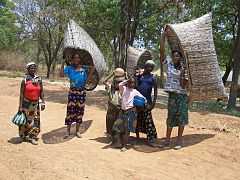
Art of making pots and jars of baked clay
They collect clay from the plain or the river banks, put it in a special container called liwati and wet it with water, after pounding it they then mix it with burnt clay powder called vunga vwa vitambi.
Wood-carvings
Men cut pieces of trees and carve them into pounding sticks, mortars, spear and fish-spear shafts, knife-handles, walking sticks, axe and hoe handles, poles, curios, canoes and oars and also musical instruments, vithandthzi, a type of harp, vinkuvu, drums, stools, bowls, pounding troughs and other utensils.
Weaving, bark-cloth making
Men peel off the bark of big trees such as mushovi and munyumbe and hammer them on a plank with mallets called vithano till they become soft. These bark cloths are called vifundo and when the work is completed, the vifundo or maina! can be worn around the waist and also used as blankets.
Basket-making
Women make winnowing baskets, small bowl baskets called vingalo for food and big bowl shaped baskets called mendeko for keeping mealie meal and other things out of the roots of mijalu trees and small roots called tujalu. Men make fishing baskets called matambi out of a species of reeds called manenga, mats out of mateve (papyrus) called manala, also manala or mats out of long grass called n'olokoko as well as mavoya and kambanga water grass.
Salt-making
Long ago the Mbunda people introduced their own salt called mukele. Mukele is made out of the following grasses: mulele, stalks of maize and millet, mateve (papyrus) and cassava stalks.
Plant and animal oil-making
This is mainly for women again with the help of men. Oil is made out of wild fruits that bears fat and some of them are edible.
Apart from all that, Mbunda people cultivate the tropical forest which are found in where they live, and grow assorted crops. They grow maize, millet, sorghum, beans, and sweet potatoes and cassava being their staple food. They also keep domestic stock. Their traders before the Protuguese occupation for all these activities came into contact with the Portuguese, and Ovimbundu traders of Bié Plateau of central Angola, who largely traded in bee wax, ivory trade and rubber, in exchange with guns and cloth material.[36]
Religion
The Mbunda like many other societies of the world are a religious people. They have two religious traditions which coexist in Mbunda society: the traditional religious practices and the modern religious practices and beliefs which are a combination of traditional and Christian influences. Overwhelmingly the Vambunda follow Christianity, with roughly equal shares falling to the Catholic Church and to different Protestant denominations, mainly the Igreja Evangélica Congregacional de Angola (IECA), founded by American missionaries.
Missionary Rev. Albert Bailey, of the Africa Evangelical Fellowship (then called the South African General Mission) entered Angola in 1914 and opened a mission station on Luanginga River and, with the aid of the Mbunda speaking man from Rhodesia, engaged in compiling a vocabulary – one of the first steps in the acquisition of an unwritten language. The work of translating the Mbunda Bible was started in eanerst.
Still in 1914, a revolt by the Mbunda people against the Portuguese Colonialists following the abduction of the (21st) Mbunda Monarch, King Mwene Mbandu I Lyondthzi Kapova of the Mbundaland to the east of Angola[37] caused large numbers of the local people to flee across the border into Barotseland, now Zambia. In 1916, Mr. Bailey decided to find a more populated location and, with the Governor’s permission, built a station at Muie, in Mbundaland, under siege from the Portuguese Colonialists. In 1918, following the fall of Mbundaland at the hands of the Portuguese Colonialists in 1917, J. Jakeman and Andrew McGill relieved Mr. Bailey and established a number of out-posts among the Mbunda and Luchazi people. In the ensuing years, four more stations were established: Cunjamba, N'inda, Casuango and Catota all in the fallen Mbundaland.
The book of John, was translated by the Rev Albert W Bailey known as (Avele), it was printed at Kamundongo Mission of United Church of Canada, now IECA- Igreja Evangelica Congregacional em Angola, in 1919; The book of Matthew in Mbunda and Portuguese was translated by Abraham at Muie in 1925; The book of Mark was translated by Rev. John C Procter at Muie also in 1925 and another edition of Rev Bailey's translation was published in diglot at Muie in 1928; The book of Luke was by Mateo at Muie in 1927 and also Hymnal in Portuguese and Mbunda. The Committee of reviewers consisted of Rev. Albert W Bailey, Rev. John C Procter, A McGill, Dr P.V. Watson.
Mbunda people had books since 1919 in Mbunda language, which were destroyed by the Portuguese colonialists who considered Mbunda people as rebels and forced missionaries to translate them into Luchazi, even though in 1932 the missionaries reported that their work was being carried on among different ethnic groups: The Chokwe, Mbunda, Luchazi, Mashi, Nkangala, Umbundu, Lwimbi, Chimbandi and Songo. Others were: Mbukushu, Nyemba, Nkhumbi, Ngambwe, Omwila, Kwanyama, Kubale, Makoma and Yauma.
In 1937 Mr. and Mrs. Pearson initiated a Bible Training School at Muie, with the New Testament (published in 1935) as their only textbook. At Muie Leonard and Nellie Brain had charge of the church work and operation of the mission station.[38] However, Rev and Mrs. Emil Pearson missionary work which they started in Angola from 1919 to Sept. 1966 turned out to be a fight against the Mbunda people as opposed to Missionary J.W.V. Jakeman work who was in favour of using the Mbunda language in ministry work. Despite the hospitality from the Mbunda people, they joined the Portuguese Colonialists in increasing animosity between the Mbunda and their Luchazi brothers.
Mbunda people wanted their Bible translated in Mbunda language, but the missionaries quickly concluded that Mbunda, Luchazi and Nyemba were the same and decided to translate the Luchazi Bible instead. They joined the Portuguese Colonialists who wanted Mbunda language completely wiped out of Angola and replaced by Luchazi language in revenge for the many Portuguese lives lost at war, at the hand of the Mbunda people. Consequently, missionary Emil Pearson created Ngangela, by mixing Luvale, Luchazi, Mbunda, and Luimbi languages to allow a single translation of the Bible to serve all four communities.[39]
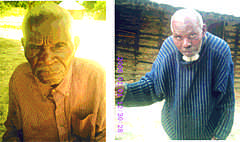
The battle for Mbunda Bible translation in Mbunda language continued, in Zambia, with Missionary Robert Wesley Brain in Luampa, Kaoma District in Zambia,[40] continuing to fight the Mbunda Bible translation work, by his reporting a Mr. Elijah Kavita who was instrumental in translating the Mbunda Bible to be a witch. All what Mr. Kavita was alleged to have uttered was that he would kill some people for fighting the Mbunda Bible translation. Missionary Brain insinuated that since an African threat to kill was not by a gun, Mr. Kavita might have meant killing by witchcraft. This supposition caused Mr. Kavita to be removed from the translation team, and the Mbunda Bible translation work came to a standstill in 1982.[41] Missionary Brain was deported from Zambia and blamed his deportation on the Mbunda people.[42]
During a Mbunda workshop conducted by Dr. Hope in 1987 participants requested that the writing of certain words in Mbunda should be standardised and, that the translators should be guided as to how to write certain Mbunda words.
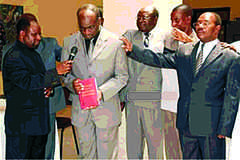
However, on 17 April 1989 it was resolved to drop the argument on the four major Luchazi spelling problems of "s", "z", "nz" and "ts" as opposed to the Mbunda "th", "thz", "ths" and "ndthz", and go ahead with the translation as there was always room for revision. The point in mind was that, the Bible Society of Zambia had received requests to review the writing in the Lozi and Bemba Bibles. The Mbunda Bible was finally printed and launched on 17 August 2008 in Angola and 31 January 2009 in Zambia. However the Mbunda Bible translation is still heavily saturated with Luchazi spellings.
Some Mbunda people though, still retain beliefs and practices from African traditional religions, believing in Njambi as a supreme creator of the world who created everything of existence on earth. Their religion did not address Njambi directly, but through the spirits of their ancestors.[43]
Traditions and rituals
The Mbunda have maintained most of their old traditions such as respect for their ancestors, “coming of age” rituals for both boys (Mukanda Initiation Ceremony and their not less than fifty Makithi artifacts), girls (Litungu or Bwali), relying on cattle, goats, wild meat, fish, chicken and cassava for their food, men carry weapons such as bow and arrows, spears or machetes when traveling away from their villages and women still creating baskets from makenge roots.[44]
At the beginning of the planting season or when a hunter failed to kill animals, the people of a village gathered at fetish poles (vimbundi) marked or coloured with red and white

clay placed in the appropriate place, often outside the house just near the door directly against the bed where the heads point when people are asleep, to worship and pray to their ancestors, before the field activities start. This is also done when making offerings to there ancestors, during sicknesses or deaths where evil spirits were suspected, when bad dreams have been experienced and when summoning rains during a drought. Offerings are made in the form of a sacrifice such as killing an animal, a chicken, goat, cow, pig or sheep or any living thing with the exception of a human being. The blood of the animal was rubbed against the fetish poles (vimbundi) as respect, praise and honour to God and the spirits.
Origin of The Mbunda Mukanda Circumcision Ritual
Mukanda, is an initiation ritual for boys, which is practiced by the Mbunda. Usually, the young boys live for three to six months at a bush camp away from their villages after circumcission, to be taught practical survival-skills as well as knowledge about nature, religion, social practices and values. During that period a Makithi masquerade of not less
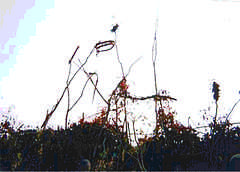
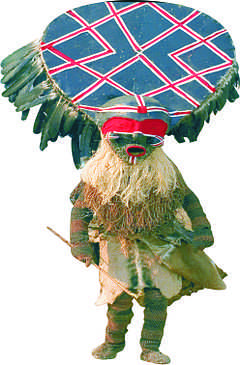
than fifty (50) exclusive Mbunda artifacts is exhibited, and dances involving the pantomime-like artistry artifacts is performed as a cultural entertainment to the community. At the end of this initiation period, the boys are reintegrated into the community. This ritual is also practiced by other ethnicities like the Chokwe the Luvale and the Luchazi, with the Mbunda being the major stakeholders in the Makishi masquerade as pronounced by others, owning not less than fifty (50) exclusive Mbunda artifacts.
It is believed that a Mbunda Prince Consort Mukwetunga Kamenga who was sent by the 10th Mbunda monarch King Mwene Katete ka Lweembe in pursuit of the elephants, strayed onto a Mukanda Circumcision camp for the Mbwela people, near the present day Angola and the Democratic Republic of the Congo border [45] in Lubaland. This led to him getting circumcised and introduced the Mukanda circumcision ritual to the Mbunda upon his return. When Prince Consort Mukwetunga Kamenga returned with the Mukanda circumcision ritual, he found King Mwene Katete ka Lweembe who sent him had died and the Prince Consort's wife, Princesses Vamunamwene Mukenge had succeeded him. Queen Vamwene Mukenge, Livindamo was the last female Mbunda monarch. That was as a result of the circumcision ritual adoption meant for men only, which led to female rulership being subordinated to male political authority. This change meant that only male royalty could be enthroned as sovereign rulers or monarchs of the Mbunda Kingdom. Female royalty could henceforth never again assume the Mbunda monarch.[46]
Mbunda Annual Ceremonies
The Mbunda have four annual ceremonies in which Mbunda people of Angola, Congo, Namibia and Zambia join to praise their Creator the Almighty God for the blessings on them in providing good harvest for the year. These ceremonies are: One in Angola called Lithathe Lya Miondo Ya Mbunda, celebrated every second week of August with the weekend being the climax, in Lumbala Nguimbo, Moxico at the palace of His Majesty King Mbandu III Mbandu Lifuti. Three in Zambia, with the first called Mbunda Mbalango Lyenya, celebrated every August at Chief Muundu palace in Liumba, Kalabo District of Western Zambia. The second called Mbunda Liyoyelo, celebrated every September at Chief Chiyengele Chingumbe II palace at Kayombo in Kabompo District of North Western Province of Zambia. The third called Mbunda Lukwakwa, celebrated during the first week of October with the weekend being the climax at Senior Chief Sikufele's palace at Manyinga in Kabompo District. All these ceremonies showcase the Mbunda makishi masquerade, wood carvings, a variety of Mbunda traditional foods and dances.
Monthly and Seasonal Activities
Names of Months
| English | Mbunda | Monthly Activities |
|---|---|---|
| January | Kavalana | In a traditional proverb it is said of January that: "Ngonde ku ivambala mawa. Ya vambala na vilya vya maxamgu".
Which means: This month is not important on its own but owes its importance to the harvesting of millet. |
| February | Kutatu | It is the month that the new crop of millet is tasted. There is not adequate relish yet food is plentiful. There are heavy rains. |
| March | Kuwana | Time to meet in field huts to drink millet brewed beer and rejoice because they have reached the time of new crops according to the Mbunda, it was their new year. |
| April | Kuhu | Time for harvests from fields to be taken home and put it in granaries. |
| May | Kathikana | The cold season is just beginning and it is time initiation ceremonies are prepared and begun |
| June | Kavavu | Time trees and grass have withered by the cold. |
| July | Kondamema | The coldness is believed to break rocks and water left outside on dishes freezes. |
| August | Kaxukwe | Trees begin to loose their leaves. Clearing and preparation of fields for cultivation, sowing and planting start. |
| September | Kapepo | Sorghum is thrashed. Signs of rain manifest themselves by the appearance of dark clouds and thunder. Forests are burned. |
| October | Lipepo | Small lakes dry up. Side paths are created to avoid the hotness of the main paths. This month is sometimes called Kwenya, meaning burning. |
| November | Kandthzimbi | Trees are green all over and flowers appear on plants. Preliminary rains have begun to shower and in scattered places heavy rains fall. These rains are called nyondthzi ya cikaluvula, meaning early rains. |
| December | Ndthzimbi | There are heavy rains. Many fruits decay; mushrooms are growing while others are rotting. Birds are not healthy. Starvation looms, because food reserves have run out. Many go to work for others to get food. This month is often referred to as Ndungu, which means hunger. |
Seasons of The Year
| English | Mbunda | Seasonal Activities |
|---|---|---|
| Summer | Ntondwe | These are the months of Kashukwe (August), Kapepo (September) and Lipepo (October). It is in this season that fields are cleared and millet is sowed and cassava plants are planted. Many fruits ripen in the forests. it is also hot and people begin to make side paths to avoid the heat of the main paths. |
| Spring or Autumn | Ndombo | This is five months including Kandthzimbi (November). Ndthzimbi (December), Kavalana (January), Kutatu (February) and Kuwana (March). During this time other fruits such as manjongolo, vithala, vixole ripen while those. which ripened in summer rot away. Mushrooms grow and become important sources of relish. People who didn't raise enough crops and have depleted stores collect these for food until the next harvest. |
| Winter | Chithika | There are four months in this season. Kuuhu (April), Kathikana (May), Kavavu (June), and Kondamema (July). In this season harvesting and grain storage are important. It is very cold and water freezes and leaves are frozen and fall off of the deciduous trees. |
Numerals
Numerical counting in Mbunda follows the usual numerals but in Mbunda words. Fill ups are easily made using small numerals.
|
1 - Chimo. 2 - Vivali. 3 - Vitatu. 4 - Viwana. 5 - Vitanu. 6 - Vitanu na chimo. 7 - Vitanu na vivali. 8 - Vitanu na vitatu. 9 - Vitanu na viwana. 10 - Likumi. 11 - Likumi na chimo. 20 - Makumi avali. 22 - Makumi avali na vivali. 30 - Makumi atatu. 33 - Makumi atatu na vitatu. 40 - Makumi awana. 44 - Makumi awana na viwana. 50 - Makumi atanu. 55 - Makumi atatu na vitanu. 60 - Makumi atanu na limo. 66 - Makumi atanu na limo na vitanu na chimo. 70 - Makumi atanu na avali. 77 - Makumi atanu na avali na vitanu na vivali. 80 - Makumi atanu na atatu. 88 - Makumi atanu na atatu na vitanu na vitatu. 90 - Makumi atanu na awana. 99 - Makumi atanu na awana na vitanu na viwana. 100 - Chiita. 101 - Chiita na kamo. 110 - Chiita na likumi. 111 - Chiita na likumi na kamo. 152 - Chiita na makumi atanu na tuvali. 163 - Chiita na makumi atanu na limo na tutanu. 174 - Chiita na makumi atanu na availi na tuwana. 185 - Chiita na makumi atanu na atatu na tutanu. 186 - Chiita na makumi atanu na atatu na tutanu na kamo. 197 - Chiita na makumi atanu na awana na tutanu na tuvali. 200 - Viita vivali. |
201 - Viita vivali na kamo. 300 - Viita vitatu. 400 - Viita viwana. 500 - Viita vitanu. 600 - Viita vitanu na chimo. 700 - Viita vitanu na vivali. 800 - Viita vitanu na vitatu. 900 - Viita vitanu na viwana. 1,000 - Likulukathzi. 1,111 - Likulukathzi na chiita na likumi na kamo. 2,000 - Makulukathzi avali. 3,000 - Makulukathzi atatu. 4,000 - Makulukathzi awana. 5,000 - Makulukathzi atanu. 6,000 - Makulukathzi atanu na limo. 7,000 - Makulukathzi atanu na avali. 8,000 - Makulukathzi atanu na atatu. 9,000 - Makulukathzi atanu na awana. 10,000 - Likumi lya makulukathzi. 11,111 - likumi lya makulukathzi na likulukathzi na chiita na likumi na kamo. 20,000 - Makumi avali amakulukathzi. 30,000 - Makumi atatu amakulukathzi. 40,000 - Makumi awana amakulukathzi. 50,000 - Makumi atanu amakulukathzi. 60,000 - Makumi atanu na limo amakulukathzi. 70,000 - Makumi atanu na avali amakulukathzi. 80,000 - makumi atanu na atatu amakulukathzi. 90,000 - makumi atanu na awana amakulukathzi. 100,000 - chiita cha makulukathzi. 200,000 - viita vivali vya makulukathzi. 300,000 - viita vitatu vya makulukathzi. 400,000 - viita viwana vya makulukathzi. 500,000 - viita vitanu vya makulukathzi. 600,000 - viita vitanu na chimo vya makulikathzi. 700,000 - viita vitanu na vivali vya makulukathzi. 800,000 - viita vitanu na vitatu vya makulukathzi. 900,000 - viita vitanu na viwana vya makulukathzi. 1,000,000 - likulukathzi lya makulukathzi. |
Names and meanings
Mbunda names are many; listed are the ones commonly used.[47] They can be given either to a male or female, except a very few that are for females only and have been indicated here by (f). Some Mbunda names are similar to those of other nationalities which also have their roots in the Luba Kingdom, such as Kaunda, Katongo, Kavanda, Mulenga, Muvanga, Mwila, Kavunda, Kalunga, Muti, Chiinga, Kavalata, Chiti, Nkonde and others. Also similar to Mbunda names are Chipoya, Chipango, Musole, Kayata, Ngambo, Kawengo, Kapisa and Musumali, found in other ethnic groups which trace their origins to Mwantiyavwa the king of the Ruund. These similarities give further evidence that Mbunda people interacted with the Kingdom of Lunda and Kingdom of Luba,[48] in the 15th century. The commonly used Mbunda names are as follows:
1. Viemba (Vyemba) meaning medicines.
2. Vulungi meaning trekking to new settlement
3. Chendamundali meaning tourist, (vacendamundali-plural).
4. Chalula meaning someone who found (picked) a lost thing.
5. Chambato meaning a bridegroom.
6. Changoco meaning a useless person.
7. Changano meaning an "I don't care" person.
8. Chavaya meaning a destitute person.
9. Chikatu meaning source.
10. Chilala meaning cruelty.
11. Chiinga meaning substitute or substitution.
12. Chiingi meaning the substitute wife from same family as first wife.
13. Chilindo meaning the float of fish net.
14. Chilombo meaning a place where things are put to soak or dye.
15. Chilunda meaning the second born.
16. Chimbali meaning the slave of a white person.
17. Chimbinde meaning a cantankerous person, cruel.
18. Chindele meaning a white person.
19. Chindumba meaning a kind of hair plait.
20. Chingumbe meaning a strong and healthy man. Name of the 14th Mbunda King who ruled Mbundaland in the 17th century in what is now Angola.
21. Chingunde meaning moroseness, sullenness.
22. Chingwali meaning a shackle for the head, a fetter.
23. Chinjenge meaning to be left in hardship.
24. Chinunga meaning an articulated joint.
25. Chinyundu meaning a beehive smoker (to rid the hive of bees).
26. Chioola meaning a quiet person; sober.
27. Chipango meaning the fence built for a woman giving birth.
28. Chipipa meaning to swish or whip through the air.
29. Chipoya meaning a machile or hammock.
30. Chiputa meaning a type of shrub; bush.
31. Chixwaxwa (Chishwashwa) meaning an empty light shell.
32. Chiti meaning wood or tree.
33. Chitumbo meaning a big heap of soil.
34. Chitundu meaning a type of plant with an edible tuber.
35. Chiyengele meaning a red cloth belt. Name of the Senior Mbunda Chief in Bulozi, declared by King Mulena Mulambwa of the Aluyi people.
36. Chiyengo meaning big barrel.
37. Chuma meaning thing.
38. Kaalu meaning a surviving twin.
39. Kavavu meaning June.
40. Kafunya meaning a presumptuous person.
41. Kafuti meaning the child born after twins.
42. Kailu meaning the child born after five children's death, regarded as a "returned" person.
43. Kaliki meaning the chief's storehouse.
44. Kaliye meaning being lonely.
45. Kalimbwe (vulimbwe) meaning a person using birdlime to catch birds.
46. Kalumbu, for females, meaning a stray person who has lost her good character.
47. Kaliata (Kalyata) meaning a person who oppresses others.
48. Kaliangu (Kalyangu) meaning a kind of jester or masked dancer.
49. Kamana meaning a wise person.
50. Kanjengo meaning white cloth.
51. Kankondo meaning a kind of weasel that eats fowls.
52. Kanjonja meaning a type of gun; flintlock.
53. Kanunga meaning a small joint.
54. Kapatitho (Kapatiso) meaning bolt fastener.
55. Kapitha (Kapisa) meaning a person who refuses to help because he is miserly and stingy or who burns something.
56. Kaxweka (Kashweka) meaning a hidden thing.
57. Kaxukwe (Kashukwe) meaning August.
58. Kathoka (Kasoka) meaning a person who loads the gun; rams the charge into the gun.
59. Kathonda (Kasonda) (vuthampu - vusampu) meaning a kind of coiffure.
60. Katavola meaning a person who tears something apart. Name of the famous 20th Mbunda King who fought and defeated the Chokwe people in what is now Angola.
61. Katota meaning a person who knocks or hammers on something.
62. Katongo meaning a wanderer.
63. Kaulembi (kulamba) meaning a person who goes to appeal for help.
64. Kavindama meaning an unfortunate person.
65. Kavunda meaning a person who smears the concrete floor.
66. Kawengo meaning the spirit of a deceased woman.
67. Kayando meaning a sufferer, trouble.
68. Kayawe meaning a cunning person.
69. Kayongo meaning the spirit of a deceased man.
70. Kathzungo (Kazungo) meaning noise or racket. Name of the 22nd Mbunda King who was installed by the Portuguese colonialists, after abducting King Mwene Mbandu I Lyondthzi Kapova, the 21st Monarch of Mbundaland in what is now Angola.
71. Kufuna meaning to and fro. (Not Mbunda by origin but used today).
72. Kalunga meaning God.
73. Kuunga meaning to gather.
74. Kuvangu, see Kawengo.
75. Lifuti meaning country. Name of the 23rd Mbunda King and the first to be installed by the Mbunda people after the restoration of the Mbunda monarchy in what is now Angola, since the abduction of the 21st Mbunda King who resisted the Portuguese occupation of Mbundaland in 1914.
76. Likonge meaning a kind of water grass.
77. Liongo meaning a river reed.
78. Livindamo meaning an unlucky village or place.
79. Luvinda meaning hard luck or misfortune.
80. Liwoyo meaning racket, noise.
81. Lumbala is the name of a river in eastern Angola.
82. Liato (Lyato) meaning a big canoe.
83. Liunda (Lyunda) meaning grove.
84. Maamba meaning evil spirits possessing people.
85. Makayi meaning bracelets.
86. Makalu meaning a brave person.
87. Makuwa from (kulikuwa) meaning someone who shouts when rejoicing.
88. Maliti meaning a type of rifle, a single loader.
89. Manjolo meaning tubular anklets.
90. Manyenga meaning a worried person, also means to render fat.
91. Mathambo (Masambo) meaning small wires.
92. Matheka (Maseka), see Makayi.
93. Mathumba (Masumba) meaning crescent shaped medallions.
94. Mbaita (f) meaning please pass, to allow to pass.
95. Mbalili (f) meaning keg, barrel.
96. Mbambale meaning the spinning device used by Mbunda.
97. Mbandu meaning sore. Name of the 21st Mbunda King who resisted the Portuguese occupation of Mbundaland in 1914 in what is now Angola.
98. Mbundi (f) meaning a fetish stick.
99. Mukovoto meaning a talkative person.
100. Mukuve meaning a kind of tree for bark rope.
101. Mukwita meaning a passer-by; to pass by.
102. Mulenga meaning a piece of wood split off a tree struck by thunder and lightning.
103. Mulemba meaning a kind of tree that produces rubber.
104. Mulikita meaning great big-game hunter, also boxer.
105. Muliata (Mulyata), see Kaliata (Kalyata).
106. Mundanya, see Mathumba (Masumba).
107. Mundu (kaundu) meaning medicine rubbed on the body to make it impervious to bullets. Name of the first Mbunda Chief who migrated to Bulozi in the 16th century.
108. Mundthzimba meaning an ignorant person.
109. Mununga meaning a person who joins things together.
110. Muthando (Musando) meaning millet.
111. Muthangu (Musangu) meaning a resurrected person.
112. Muxova (Mushova) (f) meaning mixed things.
113. Muxuwa (Mushuwa) (f) meaning a tree with little leaves, see mulemba.
114. Muthompa (Musompa) meaning a judge.
115. Muti (chiti) meaning tree.
116. Muvanga meaning a kind of shrub; also means firstborn.
117. Muwae (f) meaning beauty.
118. Muyeva, see Katongo.
119. Muyenga meaning to render fat or beeswax.
120. Muyombo (muxaa - mushaa) meaning a type of fetish stick.
121. Mwila meaning grass.
122. Ndandula meaning he must follow.
123. Ndombelo meaning a young girl who pounds white maize into theke (seke) which is used in ritual offerings (nombelo) to ancestral spirits.
124. Ndumba meaning lion.
125. Ngeve meaning female twins.
126. Ngongola, see Katota.
127. Nguvu meaning male twins; also hippopotamus.
128. Njamba, meaning elder of the twins; also elephant.
129. Nkumbwa meaning ostrich.
130. Nyumbu meaning a type of swamp reed.
131. Nyundu meaning otter.
132. Thakulo (Sakulo) meaning a kind of grass used for thatching.
133. Theke (Seke) meaning white maize meal used for offerings to ancestral spirits.
134. Xanda (Shanda), meaning battle, honey badger. Name of the 22nd Mbunda King who was installed by the Portuguese colonialists, after abducting King Mwene Mbandu I Lyondthzi Kapova, the 21st Monarch of Mbundaland in what is now Angola.
135. Wacama, the abbreviation of (waca manene) meaning you like something very much.
136. Wampata meaning an argumentative or stubborn person.
See also
- Mbunda language
- Bunda people
- Mbunda Kingdom
- List of The Rulers of the Mbunda Kingdom
- List of Mbunda Chiefs in Zambia
References
- ↑ Almanac of African Peoples & Nations, page 523. By Muḥammad Zuhdī Yakan, Transaction Publishers, Putgers - The State University, 35 Berrue Circle, Piscataway, New Jersey 008854-8042, ISBN 1-56000-433-9,
- ↑ Robert Papstein, The Zambia Journal of History, Central African Oral History Project, University of Zambia, ISBN 9982-03-006-X
- ↑ Almanac of African Peoples & Nations, page 523. By Muḥammad Zuhdī Yakan, Transaction Publishers, Putgers - The State University, 35 Berrue Circle, Piscataway, New Jersey 008854-8042, ISBN 1-56000-433-9,
- ↑ Ethnologue lists Yauma as "unclassified", an apparent error, as it also notes that it is "part of the Ngangela subgroup" of the Chokwe–Luchazi (K.10) Bantu languages.
- ↑ Not to be confused with the Nganguela language
- ↑ Bantu-Languages.com, citing Maniacky 1997
- ↑ Almanac of African Peoples & Nations, page 523. By Muḥammad Zuhdī Yakan, Transaction Publishers, Putgers - The State University, 35 Berrue Circle, Piscataway, New Jersey 008854-8042, ISBN 1-56000-433-9
- ↑ .Almanac of African Peoples & Nations, page 486-487. By Muḥammad Zuhdī Yakan, Transaction Publishers, Putgers - The State University, 35 Berrue Circle, Piscataway, New Jersey 008854-8042, ISBN 1-56000-433-9,
- ↑ Robert Papstein, The Zambia Journal of History, Central African Oral History Project, University of Zambia, ISBN 9982-03-006-X
- ↑ Almanac of African Peoples & Nations, page 523. By Muḥammad Zuhdī Yakan, Transaction Publishers, Putgers - The State University, 35 Berrue Circle, Piscataway, New Jersey 008854-8042, ISBN 1-56000-433-9
- ↑ Robert Papstein, The Zambia Journal of History, Central African Oral History Project, University of Zambia, ISBN 9982-03-006-X
- ↑ Ethnologue lists Yauma as "unclassified", an apparent error, as it also notes that it is "part of the Ngangela subgroup" of the Chokwe–Luchazi (K.10) Bantu languages.
- ↑ Not to be confused with the Ngangela language
- ↑ Bantu-Languages.com, citing Maniacky 1997
- ↑ http://books.google.com/books?id=gUgwAQAAIAAJ&q=chokwe+mbunda+war&dq=chokwe+mbunda+war&hl=en&sa=X&ei=SMf-Ue3IMJL64APXgoHgAw&ved=0CC8Q6AEwAA Robert Papstein, 1994, The History and Cultural Life of the Mbunda Speaking People, Lusaka Cheke Cultural Writers Association, pages 79-81, ISBN 9982-03-006-X
- ↑ Robert Papstein, 1994, The History and Cultural Life of the Mbunda Speaking People, Lusaka Cheke Cultural Writers Association, pages 68-73, ISBN 9982-03-006-X
- ↑ http://books.google.co.zm/books?id=gUgwAQAAIAAJ&q=masambo&dq=masambo&hl=en&sa=X&ei=SMf-Ue3IMJL64APXgoHgAw&redir_esc=y Robert Papstein, 1994, The History and Cultural Life of the Mbunda Speaking People, Lusaka Cheke Cultural Writers Association, pages 84, ISBN 9982-03-006-X
- ↑ Robert Papstein, 1994, The History and Cultural Life of the Mbunda Speaking People, Lusaka Cheke Cultural Writers Association, pages 74-75, ISBN 9982-03-006-X
- ↑ The elites of Barotseland, 1878-1969: a political history of Zambia's Western Province: a. Gerald L. Caplan ISBN 0-900966-38-6 Publisher: C. Hurst & Co Publishers Ltd, 1970
- ↑ Bantu-Languages.com, citing Maniacky 1997
- ↑ Encyclopedia of the Peoples of Africa and Middle East, Facts On File library of world history, Facts On File, Incorporated, Social Science, Infobase Publishing, 2009, ISBN 1-4381-2676-X, ISBN 978-1-4381-2676-0
- ↑ http://books.google.co.zm/books?id=gUgwAQAAIAAJ&q=luvale+war&dq=luvale+war&hl=en&sa=X&ei=SMf-Ue3IMJL64APXgoHgAw&redir_esc=y Robert Papstein, 1994, The History and Cultural Life of the Mbunda Speaking People, Lusaka Cheke Cultural Writers Association, pages 63-64, ISBN 9982-03-006-X
- ↑ http://books.google.co.zm/books?id=gUgwAQAAIAAJ&q=luvale+war&dq=luvale+war&hl=en&sa=X&ei=SMf-Ue3IMJL64APXgoHgAw&redir_esc=y Robert Papstein, 1994, The History and Cultural Life of the Mbunda Speaking People, Lusaka Cheke Cultural Writers Association, pages 63-64, ISBN 9982-03-006-X
- ↑ http://books.google.co.zm/books?id=gUgwAQAAIAAJ&q=mbunda+names&dq=mbunda+names&hl=en&sa=X&ei=SMf-Ue3IMJL64APXgoHgAw&redir_esc=y Robert Papstein, 1994, The History and Cultural Life of the Mbunda Speaking People, Lusaka Cheke Cultural Writers Association, pages 65, ISBN 9982-03-006-X
- ↑ Mupatu, Y. Mulambwa Santulu Uamuhela Bo Mwene, London, 1954
- ↑ Encyclopedia of the Peoples of Africa and Middle East, Facts On File library of world history, Facts On File, Incorporated, Social Science, Infobase Publishing, 2009, ISBN 1-4381-2676-X, ISBN 978-1-4381-2676-0
- ↑ Encyclopedia of the Peoples of Africa and Middle East, Facts On File library of world history, Facts On File, Incorporated, Social Science, Infobase Publishing, 2009, ISBN 1-4381-2676-X, ISBN 978-1-4381-2676-0
- ↑ Encyclopedia of the Peoples of Africa and Middle East, Facts On File library of world history, Facts On File, Incorporated, Social Science, Infobase Publishing, 2009, ISBN 1-4381-2676-X, ISBN 978-1-4381-2676-0
- ↑ White, C.M.N. Notes on the Political Organization of the Kabompo District and its Inhabitants, African Studies, IX, (1950), pp. 185-93
- ↑ Encyclopedia of the Peoples of Africa and Middle East, Facts On File library of world history, Facts On File, Incorporated, Social Science, Infobase Publishing, 2009, ISBN 1-4381-2676-X, ISBN 978-1-4381-2676-0
- ↑ René Pélissier, La révolte des Bunda (1916-1917), pp. 408 - 412 (French for "the Mbunda revolt"), section footnotes citing sources: Luís Figueira, Princesa Negra: O preço da civilização em África, Coimbra Edição do autor, 1932.
- ↑ Franz-Wilhelm Heimer, Der Entkolonisierungskonflikt in Angola, Munich: Weltforum Verlag, 1979 ISBN 3-8039-0179-0
- ↑ Franz-Wilhelm Heimer, Der Entkolonisierungskonflikt in Angola, Munich: Weltforum Verlag, 1979 ISBN 3-8039-0179-0
- ↑ Robert Papstein, The Zambia Journal of History, Central African Oral History Project, University of Zambia, ISBN 9982-03-006-X
- ↑ Encyclopedia of the Peoples of Africa and Middle East, Facts On File library of world history, Facts On File, Incorporated, Social Science, Infobase Publishing, 2009, ISBN 1-4381-2676-X, ISBN 978-1-4381-2676-0
- ↑ Robert Papstein, The Zambia Journal of History, Central African Oral History Project, University of Zambia, ISBN 9982-03-006-X
- ↑ René Pélissier, La révolte des Bunda (1916-1917), pp. 408 - 412 (French for "the Mbunda revolt"), section footnotes citing sources: Luís Figueira, Princesa Negra: O preço da civilização em África, Coimbra Edição do autor, 1932.
- ↑ Billy Graham Center Archives: Collection 252, Robert Wesley Brain, T1 Transcript
- ↑ Robert Papstein, "The Central African Historical Research Project", in Harneit-Sievers, 2002, A Place in the World: New Local Historiographies from Africa and South Asia, p. 178
- ↑ Billy Graham Center Archives: Collection 252, Robert Wesley Brain, T2 Transcript
- ↑ Billy Graham Center Archives: Collection 252, Robert Wesley Brain, T5 Transcript, last paragraph
- ↑ Billy Graham Center Archives: Collection 252, Robert Wesley Brain, T6 Transcript
- ↑ Robert Papstein, The Zambia Journal of History, Central African Oral History Project, University of Zambia, ISBN 9982-03-006-X
- ↑ Robert Papstein, The Zambia Journal of History, Central African Oral History Project, University of Zambia, ISBN 9982-03-006-X
- ↑ Terms of Trade and Terms of Trust: The History and Contexts of Pre-colonial ...By Achim von Oppen, page 113 refers
- ↑ Robert Papstein, The Zambia Journal of History, Central African Oral History Project, University of Zambia, ISBN 9982-03-006-X
- ↑ http://books.google.co.zm/books?id=gUgwAQAAIAAJ&q=mbunda+names&dq=mbunda+names&hl=en&sa=X&ei=SMf-Ue3IMJL64APXgoHgAw&redir_esc=y
- ↑ Almanac of African Peoples & Nations, page 523. By Muḥammad Zuhdī Yakan, Transaction Publishers, Rutgers - The State University, 35 Berrue Circle, Piscataway, New Jersey 008854-8042, ISBN 1-56000-433-9,
External links
| Wikimedia Commons has media related to Mbunda people. |
Coordinates: 14°06′44″S 21°26′07″E / 14.11222°S 21.43528°E
Category:Populated places in Moxico Province Category:Populated places in Cuando Cubango Province Category:Municipalities of Angola
